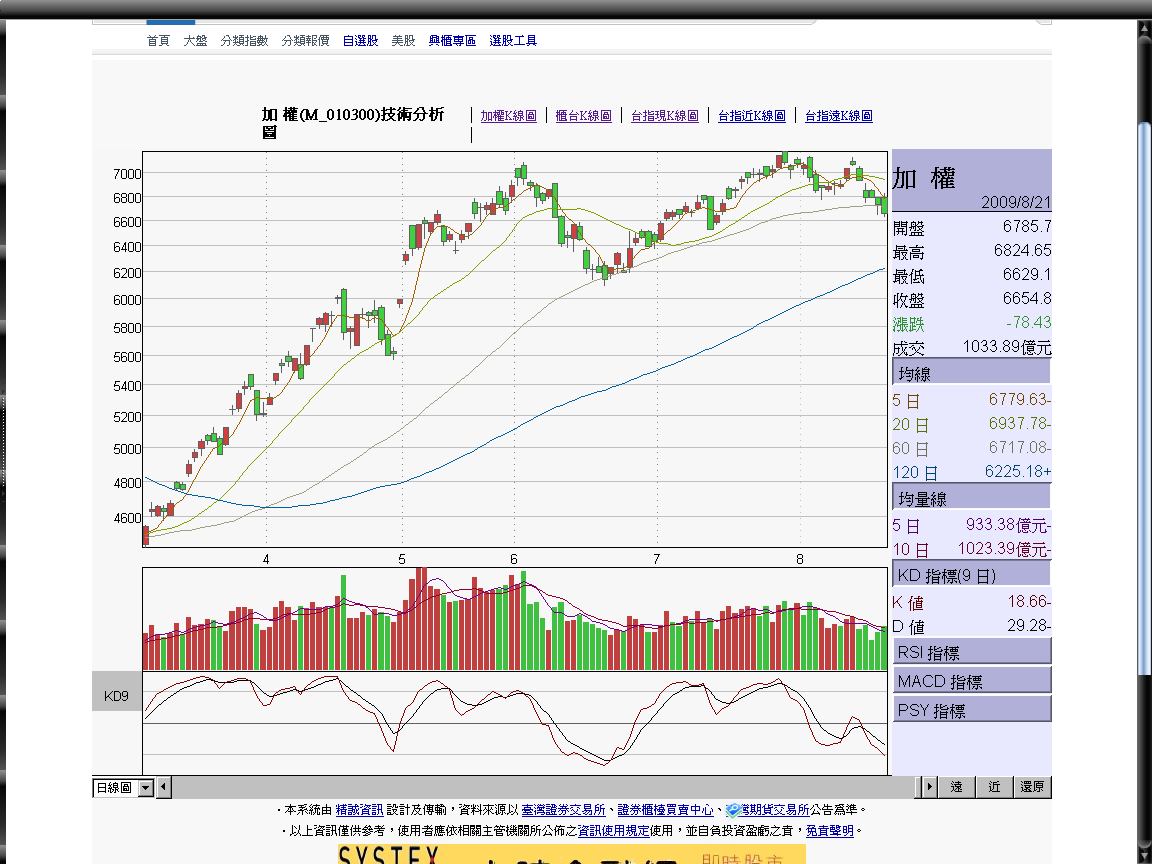
1.拉第二波解套自救波 量價背離
2.
3.最弱勢的指數
4.夜星
出貨台的邪惡宣言,偶的預感偶還真的沒想到可以準到這種地步 ,「留長下影線」實在太經典了
《各報要聞》麥格理:台股恐拉回1,000點
2009/08/20 07:48 時報資訊
【時報-各報要聞】麥格理資本證券台灣區研究部主管張博淇昨(19)日指出,基於5大理由(資金動能即將到頂、企業獲利高點已屆、投資價值不再便宜、中國題材降溫、國民黨執政危機)考量,台股將無可避免從7,135點波段高點起,出現一波幅度逾1,000點的技術性拉回走勢。
「莫拉克政治風暴」逼得總統馬英九緊急召開中外記者會,但反映在昨天台股壓尾盤的表現上,顯然無法取信於投資人,港商德意志證券台灣區研究部主管王俊朗認為,馬英九民調支持度從60%跌掉一半至30%,從近期台股表現來看,顯然散戶對台股投資信心已盡失。
王俊朗指出,短期來看,台股成交動能趨緩與指數表現欠佳已說明一切,長期而言,市場開始擔心國民黨2012年政權是否能續保,直接衝擊到的是已進入常軌的兩岸關係是否再生變。
除此之外,張博淇在近期海外marketing時,就向國際機構投資人陳述台股將出現技術性拉回的基調,他認為,台股長線仍看好沒有錯,但未來3個月內指數會浮現拉回盤整風險,且按慣例,拉回幅度都得超過1,000點,因此,以前波高點7,185點來看,極有可能回測6,000點。
事實上,張博淇認為,目前有5大理由迫使台股無可避免出現一波技術性拉回:一、資金動能即將到頂;二、企業獲利高點已屆;三、投資價值不再便宜;四、中國題材降溫;五、國民黨執政危機;尤其是最後兩項,在馬團隊救災行動飽受批評後,將同步衝擊年底縣市長選舉,以及未來兩岸開放政策的信心與延續性。
至於該如何佈局?張博淇認為,極短期內非科技股(如中鋼、台泥、台塑)與電信股(如中華電)將優於科技股。
至於科技股,則只能挑聯發科與緯創這種2010年成長力道題材非常確定的標的,而面板股當中的友達,則因為投資價值已低於長期平均值、股會表現有機會優於大盤。
不過,張博淇提醒,因為長線仍相當看好台股,這波技術性拉回仍是非常好的買點。
至於金融股,基本面不看好,應避開保險與證券股,但如富邦金控等風險性低的個股倒是可以考慮。
王俊朗也持相同看法,預估台股短線將拉回,中長期、也就是未來6至12個月穩步走揚,對於科技與景氣循環股仍應採逢低回補的策略。 (新聞來源:工商時報─記者張志榮/台北報導)
- Aug 22 Sat 2009 09:04
2009-8-21|空軍炸燬季線作戰成功
- Aug 20 Thu 2009 13:51
The Greenback Effect By WARREN E. BUFFETT
The butterfly effect reaches into the financial world as well. Here, the United States is spewing a potentially damaging substance into our economy — greenback emissions.
To be sure, we’ve been doing this for a reason I resoundingly applaud. Last fall, our financial system stood on the brink of a collapse that threatened a depression. The crisis required our government to display wisdom, courage and decisiveness. Fortunately, the Federal Reserve and key economic officials in both the Bush and Obama administrations responded more than ably to the need.
They made mistakes, of course. How could it have been otherwise when supposedly indestructible pillars of our economic structure were tumbling all around them? A meltdown, though, was avoided, with a gusher of federal money playing an essential role in the rescue.
The United States economy is now out of the emergency room and appears to be on a slow path to recovery. But enormous dosages of monetary medicine continue to be administered and, before long, we will need to deal with their side effects. For now, most of those effects are invisible and could indeed remain latent for a long time. Still, their threat may be as ominous as that posed by the financial crisis itself.
To understand this threat, we need to look at where we stand historically. If we leave aside the war-impacted years of 1942 to 1946, the largest annual deficit the United States has incurred since 1920 was 6 percent of gross domestic product. This fiscal year, though, the deficit will rise to about 13 percent of G.D.P., more than twice the non-wartime record. In dollars, that equates to a staggering $1.8 trillion. Fiscally, we are in uncharted territory.
Because of this gigantic deficit, our country’s “net debt” (that is, the amount held publicly) is mushrooming. During this fiscal year, it will increase more than one percentage point per month, climbing to about 56 percent of G.D.P. from 41 percent. Admittedly, other countries, like Japan and Italy, have far higher ratios and no one can know the precise level of net debt to G.D.P. at which the United States will lose its reputation for financial integrity. But a few more years like this one and we will find out.
An increase in federal debt can be financed in three ways: borrowing from foreigners, borrowing from our own citizens or, through a roundabout process, printing money. Let’s look at the prospects for each individually — and in combination.
The current account deficit — dollars that we force-feed to the rest of the world and that must then be invested — will be $400 billion or so this year. Assume, in a relatively benign scenario, that all of this is directed by the recipients — China leads the list — to purchases of United States debt. Never mind that this all-Treasuries allocation is no sure thing: some countries may decide that purchasing American stocks, real estate or entire companies makes more sense than soaking up dollar-denominated bonds. Rumblings to that effect have recently increased.
Then take the second element of the scenario — borrowing from our own citizens. Assume that Americans save $500 billion, far above what they’ve saved recently but perhaps consistent with the changing national mood. Finally, assume that these citizens opt to put all their savings into United States Treasuries (partly through intermediaries like banks).
Even with these heroic assumptions, the Treasury will be obliged to find another $900 billion to finance the remainder of the $1.8 trillion of debt it is issuing. Washington’s printing presses will need to work overtime.
- Aug 16 Sun 2009 20:57
ROOKIES ~キセキ~
太熱血啦~
雖然由一群高齡高中生演出的 XD
塔子算漂亮,不過也不是高中女生啊~
- Aug 09 Sun 2009 12:01
芬蘭精品 GOLLA lynne G410*黑底櫻花圖樣 (Wanted)
在雜誌上看到的,回家google一下,這款還蠻喜歡。
攝影包包總算有比較有設計感的產品出現了,搶眼多了,只是似乎都特別指明女生用的?
管他的,好看就好。
- Aug 05 Wed 2009 12:40
I've been an optimist on China. But I'm starting to worry By Stephen Roach
On the surface, China appears to be leading the world from recession to recovery. After coming to a virtual standstill in late 2008, at least as measured quarter-to-quarter, economic growth accelerated sharply in spring 2009.
A back-of-the envelope calculation suggests China may have accounted for as much as 2 percentage points of annualised growth in inflation-adjusted world output in the second quarter of 2009. With contractions moderating elsewhere, China's rebound may have been enough in and of itself to allow global gross domestic product to eke out a small positive gain for the first time since last summer.
That's the good news. The bad news is that China's recent growth spurt comes at a steep price. Fearful that its recent economic short- fall would deepen, Chinese policymakers have opted for quantity over quality in setting macro-strategy, the centrepiece of which is an enormous surge in infrastructure spending funded by a burst of bank lending.
Sure, developing nations always need more infrastructure. But China has taken this to extremes. Infrastructure expenditure (including Sichuan earthquake reconstruction) accounts for fully 72 per cent of China's recently enacted Rmb4,000bn ($585bn) stimulus. The government urged the banks to step up and fund the package. And they did. In the first six months of 2009, bank loans totalled Rmb7,400bn - three times the pace in the first half of 2008 and the strongest six-month lending surge on record.
This outsized bank-directed investment stimulus leaves little doubt as to how bad it was in China in late 2008 and early 2009. An unprecedented external demand shock, stemming from rare synchronous recessions in the developed world, devastated the export-led Chinese growth machine. That triggered sackings of more than 20m migrant workers in export-intensive Guangdong province. Long fixated on social stability, Beijing moved to arrest this deterioration. The government was determined to do whatever it took to restore rapid growth.

